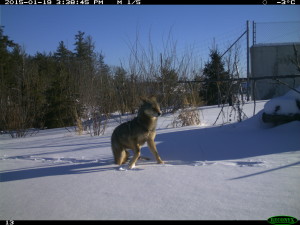Moving Our Animals – Under and Over in NE Ontario
Overpass and Tunnel
Benefits to Animals and Humans
Animal Bridges – Wildlife Crossings
by Back Roads Bill
You’re driving north to your next BIG experience in Northeastern Ontario, most likely on Highways 11 or 69. You notice the change in landscape, the flora; consider the fauna though, the animals are part of your experience.
Why do animals cross the road? They always seem to run on to the road at the wrong time.
It occurs because wildlife and people driving vehicles are on the roads simultaneously cannot predict the behaviour of one another. You most likely have had a close encounter of the animal kind.
Review these stats. In the Ministry Transportation (MTO), Northeastern Region (NER),Wildlife Vehicle Collisions (WVCs) account for 29% of the total number of WVCs on Ontario’s Highways each year. Deer account for 61% and Moose account for 26% of all WVCs in NER. When looking at these data on Highway 11 between Huntsville and North Bay, deer account for 76% and moose for 11% of the WVCs. On this same section of Highway, a distance of approximately 116 km, there were 1,320 WVCs between 2000 and 2010. Wow! On the long term, consider all the personal and insurance costs, post-accident and the unnecessary road kill.
Solutions
Animal bridges are also known as ecoducts or wildlife crossings. New solutions to wildlife crossing infrastructure are intended to reduce the costs and to tailor each type of crossing to species in various landscape contexts. And they have proven remarkably successful in restoring ecological connectivity and in improving road safety.
It started in British Columbia (Banff) and the MTO followed; there are two regional examples with good storylines. Andrew Healy, is a MTO Environmental Planner and is passionate about what is being designed and implemented. He recognizes the environmental and safety issues in our Northern Ontario context.
“The main goal is to improve driver safety by erecting wildlife exclusion fencing along the highway right-of-way. The wildlife crossings provide a safe place for the wildlife to cross, in the absence of which wildlife has been proven to follow the fence until they can cross at the ends. In addition to providing safety to both drivers and wildlife, the crossings help to reduce the barrier effect of the new highway on wildlife populations.”
Under and Over
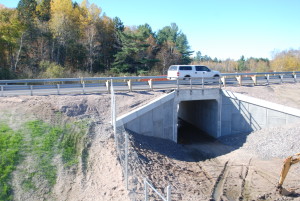 The Wasi Wildlife Underpass was completed in 2013, as part of the Highway 11 reconstruction in that area. The wildlife culvert is two separate, four metre by four metre concrete box culverts, with a median opening to allow light through avoiding a tunnel effect. More than 2 km of wildlife exclusion fencing funnels animals towards the crossing. The cost of the wildlife underpass was approximately $1M. It is just south of Callander (Lake Nosbonsing/Wasi exit) on Highway 11 South and just south of the truck inspection station (west side) 1.1 km south of Watson Rd. and 0.9 km north of Hills Rd./18th Concession Line. There is a moose crossing sign and you can safely pull “way off” on to the shoulder to safely have a look-see.
The Wasi Wildlife Underpass was completed in 2013, as part of the Highway 11 reconstruction in that area. The wildlife culvert is two separate, four metre by four metre concrete box culverts, with a median opening to allow light through avoiding a tunnel effect. More than 2 km of wildlife exclusion fencing funnels animals towards the crossing. The cost of the wildlife underpass was approximately $1M. It is just south of Callander (Lake Nosbonsing/Wasi exit) on Highway 11 South and just south of the truck inspection station (west side) 1.1 km south of Watson Rd. and 0.9 km north of Hills Rd./18th Concession Line. There is a moose crossing sign and you can safely pull “way off” on to the shoulder to safely have a look-see.
Construction of the Highway 69 overpass began in 2009. It is located 32 km south of Sudbury just before the exit to 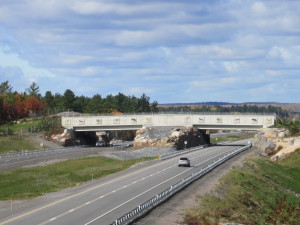 Killarney, Highway 637; you can’t miss the animal icons, it’s a tourist attraction.
Killarney, Highway 637; you can’t miss the animal icons, it’s a tourist attraction.
Wildlife collisions are a serious safety concern on Highways 69 and 11. In addition to frequent collisions, there are high severity collisions due to the prevalence of moose along the corridor. “During Route Planning and Environmental Assessment Studies wildlife collision hotspots were identified and commitments were made to mitigate collisions in these areas.”
The span of the wildlife bridge is about 80m, and it is 30m wide. It is actually two separate bridges, and it is built using the rock outcrops which is very unique. There is 60cm of topsoil on top and is landscaped. “The vegetation is now so thick that it needs to be trimmed in order to get the sightlines for the monitoring cameras.”
The final landscaping was completed in the spring of 2012. About 1 km north of the overpass is a large wildlife underpass, constructed at the same time. Additional wildlife collision mitigation will continue in conjunction with the Highway 69 four-laning. The cost of the wildlife overpass was $2.9M. The adjacent large wildlife underpass cost $1M and the wildlife fencing in this area (10 km) cost approximately $1M. An additional eight underpasses for small animals (turtles and snakes) were constructed as part of the 20 km of four lane completed in 2015 north of Highway 607.
There is detailed information about “repels” vs successful crossings. The wildlife bridge has a very high crossing rate, approximately 95% of the animals that approach will cross. The underpass is closer to 50% but he says it is increasing each year. There were 119 documented crossings of the Wasi underpass in the first year, mainly deer and primarily in the fall.
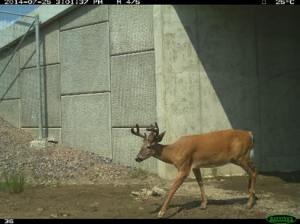 “The wildlife bridge on Highway 69 has had over 1,000 animal crossings in its first three years. Most of the crossings have been deer (74%), though moose, bear and wolf utilize it routinely. Similarly, the underpasses on Highway 69 and Highway 11 have been used extensively though in smaller numbers than the bridge. We’re also acquiring some really interesting data in terms of seasonal, sex and age usage that is demonstrating how the crossings are effectively maintaining habitat connectivity.”
“The wildlife bridge on Highway 69 has had over 1,000 animal crossings in its first three years. Most of the crossings have been deer (74%), though moose, bear and wolf utilize it routinely. Similarly, the underpasses on Highway 69 and Highway 11 have been used extensively though in smaller numbers than the bridge. We’re also acquiring some really interesting data in terms of seasonal, sex and age usage that is demonstrating how the crossings are effectively maintaining habitat connectivity.”
Gates
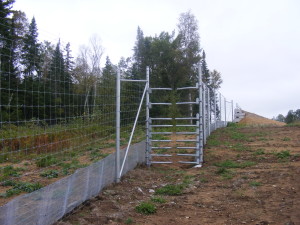 Slow down and pull off to the side of the road and look closely at the fence line. You will spot these interesting turnstiles, “kinda like” going into the large grocery stores. And the animals use them to.
Slow down and pull off to the side of the road and look closely at the fence line. You will spot these interesting turnstiles, “kinda like” going into the large grocery stores. And the animals use them to.
Wildlife fencing includes one-way escapes as a means for trapped animals to exit the right-of-way. Both the gates and ramps have been used by small numbers of deer and bear. He said, they have not yet been used by moose, though there are fewer moose breaches of the fencing. Some gates have been problematic in allowing deer and bear to move through them both ways. Escape ramps will be included in the next phase of Highway 69 expansion.
The gates are spring loaded bars that move independent of one another. The bars will open about 90 degrees and then return to their original position. “We have a few different configurations. One is to have the gate set perpendicular to the fence line. The bars are farther apart near the top.” He made this change hoping that it may be more appealing for deer/moose at their head height; good thinking.
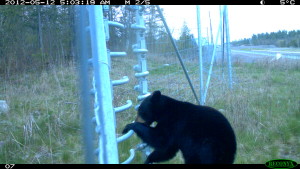 Animals walk down the fence and usually do notice the gates. “I have found that it seems to be more of a learned behaviour to use them rather than instinctual. Bears have learned to go both ways fairly easily, and we are having more success with the jump-out ramps.”
Animals walk down the fence and usually do notice the gates. “I have found that it seems to be more of a learned behaviour to use them rather than instinctual. Bears have learned to go both ways fairly easily, and we are having more success with the jump-out ramps.”
Hmmm… it is an infrastructure way of persuading wildlife to move towards a crossing point; easier than the YouTube, ‘Cowboys herding cats,’ 69 seconds; “Herding cats, don’t let anyone tell you it’s easy.” Wildlife crossings really work. Most likely the difference between domesticated and wild animals(?).
![moosecamera2[1] (2)](http://www.steerto.com/wp-content/uploads/2016/05/moosecamera21-2-300x169.jpg) Has wildlife fencing reduced collisions? “The short answer is yes, however it’s not as simple as that. We’ve had
Has wildlife fencing reduced collisions? “The short answer is yes, however it’s not as simple as that. We’ve had 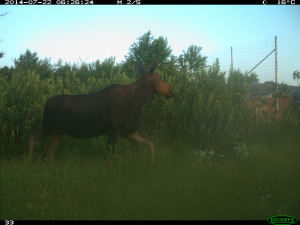 varying effectiveness with the different sections of fencing depending on the number of gaps in the fencing (ie. entrances, interchanges) and whether alternative crossing opportunities are available. Most of the fence breaches are by deer and bear, whereas moose are easier to keep out, which does limit the severity of collisions within fenced sections. Utilizing wildlife collision data to determine effectiveness is a challenge for reasons such as a lack of driver reporting, and the absence of existing data when building new four-lane alignments. The most substantial analysis we have is for the section of fencing on Highway 69 north of the Highway 637 interchange, where wildlife collisions have been reduced by approximately 70% to date.” There have also been no documented moose collisions within fenced sections on Highway 69 which is a big positive.
varying effectiveness with the different sections of fencing depending on the number of gaps in the fencing (ie. entrances, interchanges) and whether alternative crossing opportunities are available. Most of the fence breaches are by deer and bear, whereas moose are easier to keep out, which does limit the severity of collisions within fenced sections. Utilizing wildlife collision data to determine effectiveness is a challenge for reasons such as a lack of driver reporting, and the absence of existing data when building new four-lane alignments. The most substantial analysis we have is for the section of fencing on Highway 69 north of the Highway 637 interchange, where wildlife collisions have been reduced by approximately 70% to date.” There have also been no documented moose collisions within fenced sections on Highway 69 which is a big positive.
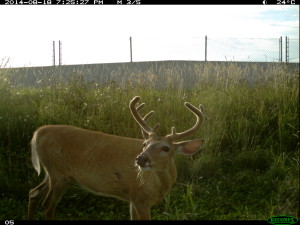 The camera utililized is a Reconyx game camera, not as expensive as you might think. They use 12 AA batteries each, when using lithium batteries you can months of use in the summer and about four weeks in the winter. The cameras take rapid fire stills as opposed to video. “Sorting through the photos is a time consuming exercise. Theft of cameras is an ongoing issue, part of the cost of monitoring.”
The camera utililized is a Reconyx game camera, not as expensive as you might think. They use 12 AA batteries each, when using lithium batteries you can months of use in the summer and about four weeks in the winter. The cameras take rapid fire stills as opposed to video. “Sorting through the photos is a time consuming exercise. Theft of cameras is an ongoing issue, part of the cost of monitoring.”![Deer_good_light[1] (2)](http://www.steerto.com/wp-content/uploads/2016/05/Deer_good_light1-2-300x169.jpg)
A pre and post collision analysis is yet to be done as it requires five years of post construction collision data. Continuous research and monitoring of the wildlife crossing structures will identify future crossings on Highways, 11, 17 and 69. Why did all these animals cross the road? Probably because they all had very important things to do on the other side it’s what you’d expect. You’ll be back to Northeastern Ontario looking for the animals and your next experience.
Google Map
